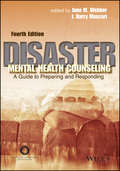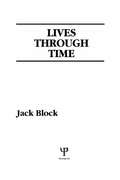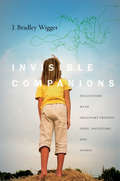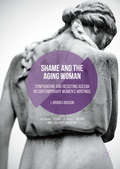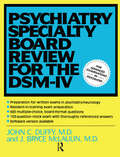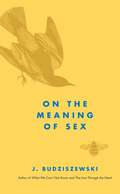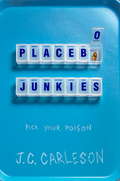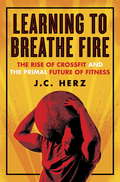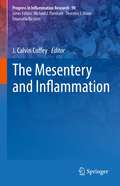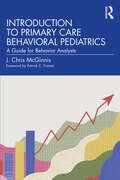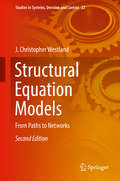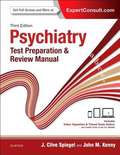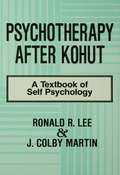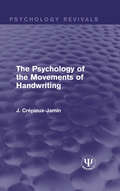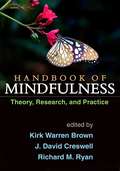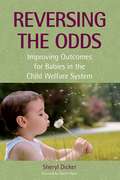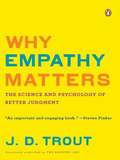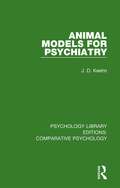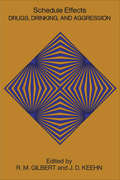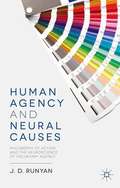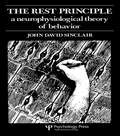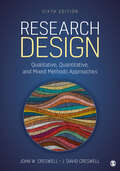- Table View
- List View
Disaster Mental Health Counseling: A Guide to Preparing and Responding
by Jane M. Webber J. Barry MascariThis timely book provides current research and skill-building information on Disaster Mental Health Counseling for counselors, educators, students, and mental health responders in agencies, schools, universities, and private practice. Recognized experts in the field detail effective clinical interventions with survivors in the immediate, intermediate, and long-term aftermath of traumatic events. This extensively revised edition, which meets 2016 CACREP Standards for disaster and trauma competencies, is divided into three sections: Disaster Mental Health Counseling Foundations, Disaster and Trauma Response in the Community, and Disasters and Mass Violence at Schools and Universities. Real-world responses to violence and tragedies among diverse populations in a variety of settings are presented, and responders share their personal stories and vital lessons learned through an "In Our Own Words" feature. Each chapter contains discussion questions and case studies are interwoven throughout the text. Requests for digital versions from the ACA can be found on wiley.com. To request print copies, please visit the ACA website here. Reproduction requests for material from books published by ACA should be directed to permissions@counseling.org
Lives Through Time
by J. BlockFirst published in 1983. Routledge is an imprint of Taylor & Francis, an informa company.
Invisible Companions: Encounters with Imaginary Friends, Gods, Ancestors, and Angels (Spiritual Phenomena)
by J. Bradley WiggerFrom the US to Nepal, author J. Bradley Wigger travels five countries on three continents to hear children describe their invisible friends—one-hundred-year-old robins and blue dogs, dinosaurs and teapots, pretend families and shape-shifting aliens—companions springing from the deep well of childhood imagination. Drawing on these interviews, as well as a new wave of developmental research, he finds a fluid and flexible quality to the imaginative mind that is central to learning, co-operation, and paradoxically, to real-world rationality. Yet Wigger steps beyond psychological territory to explore the religious significance of the kind of mind that develops relationships with invisible beings. Alongside Cinderella the blue dog, Quack-Quack the duck, and Dino the dinosaur are angels, ancestors, spirits, and gods. What he uncovers is a profound capacity in the religious imagination to see through the surface of reality to more than meets the eye. Punctuated throughout by children's colorful drawings of their see-through interlocutors, the book is highly engaging and alternately endearing, moving, and humorous. Not just for parents or for those who work with children, Invisible Companions will appeal to anyone interested in our mind's creative and spiritual possibilities.
Shame and the Aging Woman
by J. Brooks BousonThis book brings together the research findings of contemporary feminist age studies scholars, shame theorists, and feminist gerontologists in order to unfurl the affective dynamics of gendered ageism. In her analysis of what she calls "embodied shame," J. Brooks Bouson describes older women's shame about the visible signs of aging and the health and appearance of their bodies as they undergo the normal processes of bodily aging. Examining both fictional and nonfiction works by contemporary North American and British women authors, this book offers a sustained analysis of the various ways that ageism devalues and damages the identities of otherwise psychologically healthy women in our graying culture. Shame theory, as Bouson shows, astutely explains why gendered ageism is so deeply entrenched in our culture and why even aging feminists may succumb to this distressing, but sometimes hidden, cultural affliction.
Understanding Individual Differences in Language Development Across the School Years
by J. Bruce Tomblin Marilyn A. NippoldThis volume presents the findings of a large-scale study of individual differences in spoken (and heard) language development during the school years. The goal of the study was to investigate the degree to which language abilities at school entry were stable over time and influential in the child’s overall success in important aspects of development. The methodology was a longitudinal study of over 600 children in the US Midwest during a 10-year period. The language skills of these children -- along with reading, academic, and psychosocial outcomes -- were measured. There was intentional oversampling of children with poor language ability without being associated with other developmental or sensory disorders. Furthermore, these children could be sub-grouped based on their nonverbal abilities, such that one group represents children with specific language impairment (SLI), and the other group with nonspecific language impairment (NLI) represents poor language along with depressed nonverbal abilities. Throughout the book, the authors consider whether these distinctions are supported by evidence obtained in this study and which aspects of development are impacted by poor language ability. Data are provided that allow conclusions to be made regarding the level of risk associated with different degrees of poor language and whether this risk should be viewed as lying on a continuum. The volume will appeal to researchers and professionals with an interest in children’s language development, particularly those working with children who have a range of language impairments. This includes Speech and Language Pathologists; Child Neuropsychologists; Clinical Psychologists working in Education, as well as Psycholinguists and Developmental Psychologists.
Psychiatry Specialty Board Review For The DSM-IV (Continuing Education in Psychiatry and Psychology Series #5)
by John Duffy J. Bryce McLaulinFirst published in 1996. Routledge is an imprint of Taylor & Francis, an informa company.
On the Meaning of Sex
by J. BudziszewskiOur society is obsessed with sex - and yet we don't understand it at all. Acclaimed philosopher J. Budziszewski remedies the problem in this wise, gracefully written book about the nature, meaning, and mysteries of sexuality. On the Meaning of Sex corrects the most prevalent errors about sex - particularly those of the sexual revolution, which by mistaking pleasure for a good in itself has caused untold pain and suffering.
Placebo Junkies
by J. C. CarlesonGoing Bovine meets Trainspotting in this gritty portrait of at-risk teens gaming the prescription drug trial system. Meet Audie: Professional lab rat. Guinea pig. Serial human test subject. For Audie and her friends, "volunteering" for pharmaceutical drug trials means a quick fix and easy cash. Sure, there's the occasional nasty side effect, but Audie's got things under control. If Monday's pill causes a rash, Tuesday's ointment usually clears it right up. Wednesday's injection soothes the sting from Tuesday's "cure," and Thursday's procedure makes her forget all about Wednesday's headache. By the time Friday rolls around, there's plenty of cash in hand and perhaps even a slot in a government-funded psilocybin study, because WEEKEND! But the best fix of all is her boyfriend, Dylan, whose terminal illness just makes them even more compatible. He's turning eighteen soon, so Audie is saving up to make it an unforgettable birthday. That means more drug trials than ever before, but Dylan is worth it. No pain, no gain, Audie tells herself as the pills wear away at her body and mind. No pain, no gain, she repeats as her grip on reality starts to slide. . . . Raw and irreverent, Placebo Junkies will captivate readers until the very end, when author J. C. Carleson leans in for a final twist of the knife.
Learning to Breathe Fire
by J. C. HerzThe absorbing, definitive account of CrossFit's origins, its explosive grassroots growth, and its emergence as a global phenomenon. One of the most illuminating books ever on a sports subculture, Learning to Breathe Fire combines vivid sports writing with a thoughtful meditation on what it means to be human. In the book, veteran journalist J.C. Herz explains the science of maximum effort, why the modern gym fails an obese society, and the psychic rewards of ending up on the floor feeling as though you're about to die. The story traces CrossFit's rise, from a single underground gym in Santa Cruz to its adoption as the workout of choice for elite special forces, firefighters and cops, to its popularity as the go-to fitness routine for regular Joes and Janes. Especially riveting is Herz's description of The CrossFit Games, which begin as an informal throw-down on a California ranch and evolve into a televised global proving ground for the fittest men and women on Earth, as well as hundreds of thousands of lesser mortals. In her portrayal of the sport's star athletes, its passionate coaches and its "chief armorer," Rogue Fitness, Herz powerfully evokes the uniqueness of a fitness culture that cultivates primal fierceness in average people. And in the shared ordeal of an all-consuming workout, she unearths the ritual intensity that's been with us since humans invented sports, showing us how, on a deep level, we're all tribal hunters and first responders, waiting for the signal to go all-out. From the Hardcover edition.
The Mesentery and Inflammation (Progress in Inflammation Research #90)
by J. Calvin CoffeyThe volume summarizes the most recent advances in our understanding of the mesentery and explains the how these are important in inflammation. It comprises a series of state of the art chapters by leading authorities in each area. It explains how recent advances in our understanding of the mesenteric organ, have advanced the diagnosis and treatment abdominal and systemic conditions including cancer, inflammatory bowel disease and endocrine conditions such as diabetes, and circulatory disorders such as atherosclerosis.
Introduction to Primary Care Behavioral Pediatrics: A Guide for Behavior Analysts
by J. Chris McGinnisThis book is a comprehensive yet practical guide to the practice of primary care behavioral pediatrics for behavior analysts.Practitioners of this subspecialty work collaboratively with caregivers, educators, pediatricians, and pediatric specialists to bring about success for primarily neurotypical children experiencing difficulties with everything from sleep and cooperation to attention, anxiety, and toileting. This book reviews the historical and theoretical foundations of the subspecialty and provides practical guidance for problem conceptualization, assessment, case formulation, treatment planning, science-based behavioral treatment, caregiver treatment adherence, multidisciplinary collaboration, and ethical practice.A cornerstone for the field, Introduction to Primary Care Behavioral Pediatrics is essential for graduate students, practitioners of behavior analysis, and anyone interested in science-based pediatric behavioral healthcare.
Structural Equation Models: From Paths to Networks (Studies in Systems, Decision and Control #22)
by J. Christopher WestlandThis new edition surveys the full range of available structural equation modeling (SEM) methodologies. The book has been updated throughout to reflect the arrival of new software packages, which have made analysis much easier than in the past. Applications in a broad range of disciplines are discussed, particularly in the social sciences where many key concepts are not directly observable. This book presents SEM’s development in its proper historical context–essential to understanding the application, strengths and weaknesses of each particular method. This book also surveys the emerging path and network approaches that complement and enhance SEM, and that are growing in importance. SEM’s ability to accommodate unobservable theory constructs through latent variables is of significant importance to social scientists. Latent variable theory and application are comprehensively explained and methods are presented for extending their power, including guidelines for data preparation, sample size calculation and the special treatment of Likert scale data. Tables of software, methodologies and fit statistics provide a concise reference for any research program, helping assure that its conclusions are defensible and publishable.
Psychiatry Test Preparation And Review Manual
by J. Clive Spiegel John M. KennyCovering every area of the ABPN board exam, the 3rd Edition of Psychiatry Test Preparation and Review Manual, by Drs. J. Clive Spiegel and John M. Kenny, includes 1,100 questions, video vignettes, and an online timed assessment to prepare you for certification or recertification success. You'll know exactly what to expect when exam day arrives, thanks to current coverage of the latest research in both psychiatry and neurology, as well as a format that precisely mimics all aspects of the written exam. Features six tests of 150 multiple-choice questions each, as well as 160 multiple-choice questions related to case vignettes. Allows you to see results broken down by topic online, so you can target areas needing further study. Bookmarking and score archiving are also available online. Allows you to exclude topics which are not included on the MOC, such as neuroscience and neurology, so you can more narrowly focus your study. Gives clear explanations for both insufficient/incorrect and correct answers, and provides recommended readings from key textbooks. Reflects the latest research and clinical practice in both psychiatry and neurology.
Psychiatry Test Preparation and Review Manual (Second Edition)
by J. Clive Spiegel John M. KennyUpdated to reflect all of the latest research in psychology and neurology, Psychiatry Test Preparation and Review Manual, 2nd Edition precisely mirrors the written ABPN board exam so you can expertly prepare and achieve your highest score. This psychiatry Q book now features over one thousand questions including an online component with all MCQs from the text, ensuring you know exactly what to expect when exam day arrives. Enhance your preparation with recommended readings from key textbooks in the field. Understand why your answers are correct or incorrect through detailed explanations of each possible response. Study as effectively as possible with 300 brand-new questions that match the current exam format, as well as 160 clinical vignette questions that are stylistically based on those appearing on the ABPN board exam and other standardized tests. Experience a realistic exam simulation online at www. expertconsult. com, where you can take timed assessment tests as well as untimed practice tests, target specific areas of weakness, exclude topics not included on the MOC exam (such as child psychiatry and neurology), and more!
Psychotherapy After Kohut: A Textbook of Self Psychology
by Ronald R. Lee J. Colby MartinHailed as "a superb textbook aimed at introducing psychoanalytic self psychology to students of psychotherapy" (Robert D. Stolorow), Psychotherapy After Kohut is unique in its grasp of the theoretical, clinical, and historical grounds of the emergence of this new psychotherapy paradigm. Lee and Martin acknowledge self psychology's roots in Freud's pioneering clinical discoveries and go on to document its specific indebtedness to the work of Sandor Ferenczi and British object relations theory. Proceeding to readable, scholarly expositions of the principal concepts introduced by Heinz Kohut, the founder of self psychology, they skillfully explore the further blossoming of the paradigm in the decade following Kohut's death. In tracing the trajectory of self psychology after Kohut, Lee and Martin pay special attention to the impact of contemporary infancy research, intersubjectivity theory, and recent empirical and clinical findings about affect development and the meaning and treatment of trauma.
The Psychology of the Movements of Handwriting (Psychology Revivals)
by J. Crepieux-JaminOriginally published in 1926, this title is a summary in English of the works of the great French graphologist Jules Crépieux-Jamin. He was recognised at the time in France as the first authority on the subject of graphology, but was less well-known in England and America. This title brought his work to the English speaking world and he went on to be known as one of the most important exponents of graphology.
Handbook Of Mindfulness: Theory, Research, And Practice
by Richard Ryan Kirk Brown J. CreswellAn authoritative handbook, this volume offers both a comprehensive review of the current science of mindfulness and a guide to its ongoing evolution. Leading scholars explore mindfulness in the context of contemporary psychological theories of attention, perceptual processing, motivation, and behavior, as well as within a rich cross-disciplinary dialogue with the contemplative traditions. After surveying basic research from neurobiological, cognitive, emotional/affective, and interpersonal perspectives, the book delves into applications of mindfulness practice in healthy and clinical populations, reviewing a growing evidence base. Examined are interventions for behavioral and emotion dysregulation disorders, depression, anxiety, and addictions, and for physical health conditions.
The Language of Service Encounters: A Pragmatic-Discursive Approach
by J. César Félix-BrasdeferService encounters are ubiquitous in social interaction. We buy food and everyday items in supermarkets, convenience stores, or markets; we purchase merchandise in department stores; or we request information at a visitor information center. This book offers a comprehensive account of service encounters in commercial and non-commercial settings. Grounded in naturally occurring face-to-face interactions and drawing on a pragmatic-discursive approach, J. César Félix-Brasdefer sets out a framework for the analysis of transactional and relational talk in various contexts in the United States and Mexico. This book investigates cross-cultural and intra-lingual pragmatic variation during the negotiation of service. The author provides a broad review of research on service encounters to date, and analyzes characteristics of sales transactions, such as participants' roles, pragmatic and discourse functions of relational talk and address forms, the realization of politeness, and changes in alignment from transactional to relational talk. Examines face-to-face interactions in commercial and non-commercial service encounter settings, including the analysis of transactional and non-transactional talk. Analyzes pragmatic and sociolinguistic variation, including linguistic, regional, intra-lingual, and gender variation. Reviews and evaluates methods and techniques for the collection and analysis of corpus data in service encounters in naturalistic settings.
Reversing the Odds: Improving Outcomes for Babies in the Child Welfare System
by Sheryl Dicker J. DBabies and young children in the child welfare system have a high prevalence for physical, cognitive, and social-emotional delays—and often don't have access to the services and supports that could make all the difference. This is the book that will help professionals go beyond abuse prevention and ensure comprehensive healthy development of these vulnerable children from birth to age 3. Demystifying the world of child welfare, this book shows early childhood practitioners how to successfully navigate this complex system and collaborate with a wide range of other professionals to meet young children's needs.
Why Empathy Matters
by J. D. TroutA road map to empathic and efficient decisions and policies, constructed from new insights in the science of human judgment Faced with another's suffering, human beings feel sympathy and may even be moved to charity. However, for all our good intentions and vaunted free will, we are lousy at making the bigger decisions that actually improve lives. Why? Drawing on his sweeping and innovative research in the fields of psychology, behavioral economics, and neuroscience, philosopher and cognitive scientist J. D. Trout explains how our empathic wiring actually undermines the best interests of individuals and society. However, it is possible to bridge this "empathy gap" and improve our decision-making. Here, Trout offers a tantalizing proposal- how to vault that gap and improve the lives of not just ourselves but the lives of everyone all around the world. .
Animal Models for Psychiatry (Psychology Library Editions: Comparative Psychology)
by J. D. KeehnOriginally published in 1986, in this work Professor Keehn assesses the contributions of experimental psychology and ethology to psychiatric theory and practice at the time. He discusses the status of animals in psychopathology, and describes a number of animal clinical pictures, covering both abnormal movements and convulsions, and spontaneous behavioural disorders. He also includes animal models of such psychiatric illnesses as neurosis, psychosis, drug addiction and disorders of childhood, and examines the nature of mental illness and the status of psychiatric diagnosis. The book includes an evaluation of the ethics of experimental research with animals and a summary of humane experimental procedures. Animal Models for Psychiatry will be of special interest to psychiatrists, clinical and physiological psychologists, behavioural pharmacologists, and to veterinarians.
Schedule Effects: Drugs, Drinking, and Aggression
by R. M. Gilbert J. D. KeehnIn Toronto in 1970 the Addiction Research Foundation held a symposium on schedule-induced and schedule-dependent phenomena. The Foundation's main concerns with drug-behaviour-environment interactions, but because it is difficult to consider these interactions in isolation from general behavioural phenomena, the symposium was arranged around topics that are not specific to drug effects. This book contains those contributions to the symposium that focused on phenomena associated with schedules of reinforcement. Most of the papers have been extensively revised for the purpose of this publication. Three kinds of schedule effect are examined in the book. Schedule dependent phenomena arise when the effect on behaviour of an operation, such as the administration of a drug, depends on the schedule of reinforcement maintaining the behaviour. Two aspects of these phenomena are treated in detail by J.W. McKearney, who emphasizes drug effects, and by D.E. Blackman, who concentrates on the intrusion of stimuli that signal electric shock. A second kind of schedule effect is discussed by T. Thompson and R. Pickens, who show that reinforcing drugs are subject to scheduling variables, in common with other reinforcements. The remaining chapters focus on schedule-induced phenomena, although other schedule effects are also considered. Behaviour is schedule-induced when it occurs as the result of the application of a reinforcement schedule to other behaviour without being specified in that schedule. J.D. Keehn discusses these phenomena in the context of behaviour that cannot be accounted for in terms of the simple reinforcement model. T.D. Hawkins and his collaborators report a series of hitherto unpublished experiments, including work on alcohol intoxication as a schedule-induced phenomenon. J.L. Falk reviews the studies of schedule induced behaviour, which he labels adjunctive, and provides an account that recognizes ethological analyses of related phenomena, a feature too of the chapter by W. Wuttke and N.K. Innis. The two final chapters are concerned with aggression induced by scheduling and other factors. R.R. Hutchinson and G. Emley examine the temporal relationships of the different kinds of behaviour that can occur when electric shock is delivered at frequent intervals, and describes the effects of various drugs on these relationships. R. Ulrich and his colleagues provide a comprehensive review of shock-induced aggression and its controlling variables. The book will be of interest to advanced students and professionals in psychology, pharmacology, and related disciplines.
Human Agency and Neural Causes: Philosophy of Action and the Neuroscience of Voluntary Agency
by J. D. RunyanHuman Agency and Neural Causes provides an analysis of our everyday thought about our conduct, and the neuroscience research concerning voluntary agency. J.D. Runyan argues that our findings through neuroscience are consistent with what would be expected if we are, in fact, voluntary agents.
The Rest Principle: A Neurophysiological Theory of Behavior
by J. D. Sinclair John David SinclairFirst published in 1982. Routledge is an imprint of Taylor & Francis, an informa company.
Research Design: Qualitative, Quantitative, and Mixed Methods Approaches
by John W. Creswell J. David CreswellThe Sixth Edition of the bestselling Research Design: Qualitative, Quantitative, and Mixed Methods Approaches provides clear and concise instruction for designing research projects or developing research proposals. This user-friendly text walks readers through research methods, from reviewing the literature to writing a research question and stating a hypothesis to designing the study. At each step in the process, authors John W. Creswell and J. David Creswell address qualitative, quantitative, and mixed methods approaches to encourage readers to choose the approach that best fits the research question. The Sixth Edition has been fully revised to reflect the 7th edition of the Publication Manual of the American Psychological Association with more inclusive language, updated citation styles, and updated writing suggestions. Updates reflect the latest developments in mixed methods and new research examples throughout help capture and demonstrate new trends in research. Included with this title: LMS Cartridge: Import this title’s instructor resources into your school’s learning management system (LMS) and save time. Don’t use an LMS? You can still access all of the same online resources for this title via the password-protected Instructor Resource Site. Learn more.
